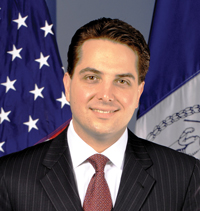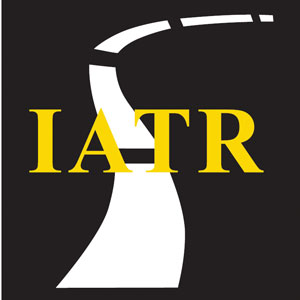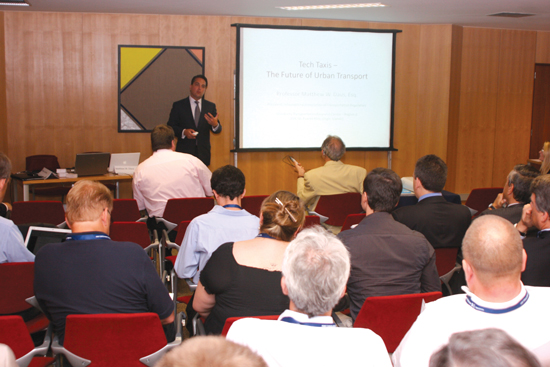 IATR — IN FOCUS
IATR — IN FOCUSPresident, International Association
of Transportation Regulators
Distinguished Lecturer, University Transportation Research Center, Region 2


 IATR — IN FOCUS IATR — IN FOCUS |
||
| by Matthew W. Daus, Esq. President, International Association of Transportation Regulators Distinguished Lecturer, University Transportation Research Center, Region 2 |
 |
 |
From July 11th through the 13th, I had the privilege of representing both the International Association of Transportation Regulators (IATR) and the University Transportation Research Center – Region 2 (UTRC) at the 12th World Conference on Transport Research (WCTR) in Lisbon, Portugal. An entire day of the conference was devoted to taxi research sponsored by the Taxi Research Network.
The WCTR is held every 3 years under the authority of the WCTR Society whose membership currently represents 64 countries and whose objective is to provide a forum for the interchange of ideas among transportation researchers, managers, policy makers, and educators from around the world from both a perspective that is multi-modal, multi-disciplinary and multi-sectoral. The World Conferences are the place where leading transportation professionals from many countries convene to learn from one another.
The Taxi Research Network is dedicated to developing, cataloguing, publishing and promoting scholarly works to furthering the
understanding and improvement of this overlooked but essential transportation mode. The organizers of the network are:
Other members of the network include institutional and academic representatives from Asia, Africa, North America and Europe.
I was pleased and privileged to receive their invitation to join the network as a principal, imparting my expertise as both a lawyer and former government regulator. The network has and will continue to work closely with the IATR, UTRC and other organizations to share research and knowledge in the realm of taxi research and policy.
One of the most important goals of the Taxi Research Network will be to periodically publish solicited scholarly articles in transportation journals dedicated to the study of taxicab and for-hire ground transportation. I am very excited about this initiative as its purpose represents one of the primary reasons why I joined the UTRC as the first experienced taxi regulator expert to be affiliated with any of these federally sanctioned research centers around the country. My goal in joining the UTRC and in working with the Taxi Research Network is to ensure that taxicabs and other private for-hire modes of transportation receive the respect, attention and devotion to scholarly research that they deserve, to further the best interests of the riding public, the government and the industry.
On “Taxi Day”, which was organized, sponsored and coordinated by the Taxi Research Network, I delivered a presentation entitled “Tech Taxis – The Future of Urban Transport.” The audience was comprised of taxi regulators, academics as well as transportation researchers and professionals. I explained how the taxi technology project in New York City was implemented in terms of the “big picture” as well as the “nuts and bolts” of how we made it happen. I provided insight into how we went from the concept, through the pilot programs, request for information, technology summit, requests for proposals and contracting process as well as new ideas for Taxi Tech 2.0. This evolution spanned my more than 8 year tenure at the TLC which is when and where the New York City technology revolutionary technology project started.
An important part of this presentation was envisioning the future of this technology program which is being replicated around the world by companies such as VeriFone. So far, NYC authorized equipment is also being used in Boston, Chicago and Philadelphia just to name a few, with inroads being made in other countries around the world. It is gratifying to see something, which was once simply a thought and which was met with skepticism both locally and internationally at first, not only blossom to be the most successful program ever implemented at the TLC, but also be cloned and reproduced around the globe.
However, the future benefits of this program in terms of its broader potential and impact upon the world transportation community are in their formative stages and just beginning to being realized. For example, just within the taxi community, I envision a day when there will be “smart taxis” – where historical GPS data can be analyzed and apprise drivers of which direction they should go to avoid traffic or increase their probability for obtaining a fare; or for prospective passengers to use their “smart phones” to communicate with “smart cabs” by sending a location based message that would be received by the nearest available taxicab to expedite and enhance service.
Also, the use of GPS taxi data to assist in broader transportation planning is in its early stages and has tremendous potential to help Departments of Transportation recognize and track vehicle speeds, patterns and flow, in order to improve transit planning and policy initiatives as well as to help enforce important traffic laws. Taxi regulators are just beginning to realize for the first time the full potential impact of the wealth of GPS generated data that can be utilized to enforce and improve safety and customer service standards as well as to assist in making sound taxicab rate of fare and leasing decisions based upon precise revenue data. For example, taxi regulators can police whether drivers are working more than the maximum number of hours permitted per day, whether fleets are running their medallions above the minimum number of days legally required, and to more effectively combat driver fraud, just to name a few.
I hope everyone enjoys what remains of this very warm summer, and I look forward to updating everyone in the Fall which promises to be very busy and full of surprises.
